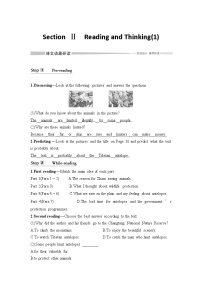


英语必修 第二册Unit 2 Wildlife protection教学设计及反思
展开
这是一份英语必修 第二册Unit 2 Wildlife protection教学设计及反思,共6页。
Unit 2 Wildlife Protection Period 1 Listening&Speaking&Talking教学设计Listening and Speaking introduces the topic of “how to save endangered wildlife and help wildlife in their neighborhood.” Due to the continuous deterioration of the living environment, a large number of wild animals are always facing the threat of endangered or extinction. Listening and speaking period enables students to understand the fact and reason why wild species are disappearing from the earth at an amazing speed, and realize that human beings ought to enhance the awareness of protecting wild species as soon as possible.Listening and Talking introduces the theme of " how to help wildlife in Ss’ neighborhood.". Now there are many volunteers who spontaneously protect wild animals, carry out various activities according to local conditions, and contribute their own strength to local animal protection with practical actions. Middle school students are also enthusiastic participants. They organize activities in their spare time, and take this opportunity to make friends, broaden their horizons, cultivate team spirit and communication skills. This section describes a bird watching activity organized by several middle school students of Bird watching Club. It aims to stimulate students' interest, improve their understanding of bird watching activities, and use the language structure of “being used for; in order to, so as to, to, so that, in order that ” to express the purpose for communication and discussion.1. Guide students to understand the content of listening texts in terms of using visuals to predict content.2. Cultivate students' ability to guess the meaning of words in listening; discuss with their peers how to save endangered wildlife and help wildlife in their neighborhood.3. Instruct students to use functional sentences of the dialogue such as “I am concerned about…” “what do you know about the endangered animals in…" and so on to talk about one of the endangered animals.4. Instruct students to use functional sentences of the dialogue such as “This is used for…” “I did it to/in order to/so as to…" and so on to talk about how to help wildlife in Ss’ neighborhood.1. Guide Ss to use the prediction strategy of reading pictures accurately to understand the content of listening texts 2. Guide Ss to express their opinions on how to participate in wildlife protection, and communicate with their peers about the living conditions and protection measures of wildlife in simple English. Part 1: Listening and SpeakingStep 1: Lead inThe teacher is advised to have a small talk about the topics:What messages do these posters share?They tell us wildlife is being hunted and under threat.Boys and girls, before our listening, let’s work in pairs and discuss Step 2: PredictionAfter their small talk, the teacher can ask students to predict what the listening text is about by looking at the pictures.Some animals are endangered and why and how we can protect them from being extinct.Listening tip: use visuals to predict contentBefore listening, look at the pictures, videos, charts and other visuals to help you predict.Step 3: Summary of the main ideaThen, play the radio which is about the dying wildlife on earth. And after finishing listening to the first part of the tape, the students need to solve the following tasks.Fill in the blanks while listeningOur planet's ____________is dying out at an alarming rate. Between 150 and 200 species are becoming ___________ every day. This mass extinction is caused by hunting, habitat _________and pollution. We must make people aware of the problem and help_______ the endangered wildlife before it's too late!wildlife extinct loss protectAfter finishing the task above, the teacher plays the second part of the tape and after finishing listening, the students need to solve the following task.Listen and answer the following questions:How many elephants are killed on average every day?54What did Prince William say about China?China can become a _________________in wildlife protection. global leader3. What does “change begins with you” mean?If you want things to change, you must change yourself first and not wait for others to be the first one to do sth, you must be the number one to start to do the first action. In this way, we can change the world for the better.Step 4: Speaking ProjectIn pairs, discuss the questions, role-play the example, and then talk about one of the animals in the photos below.1. What do you know about the animals in the photos? 2. What is being done to help them?A: I'm concerned about the blue whales. What do you know about them?B: Well, I know that they're being hunted and their number is getting dramatically smaller, so they're in danger of extinction. Blue whales need large and clear water habitats, so it's difficult for them to adapt to the changes.A: That's terrible. What measures are being taken to help them?B: The authorities are under pressure to make laws to ban illegal hunting whales and tell people not to buy whales products.Part 2: Listening and TalkingStep1:Listen to the tape, for the first time, and then ask the students to solve the following tasks.Choose the right ending for each sentence.1.Binoculars2. Build bird feeders3. Use a bird field guide4. Put paper cut-outs on windowsin order to identify birdsB. so that birds do not crash into them in order that .. .C. to make sure that birds have enough foodD. are used for watching birds from far away3. Listen and answer the questions.1. Who are the teenagers?They are from a bird watching club.2. Where are they?In the Qinling Mountains.3 What are they doing?They are searching for new wild birds and looking them up in their field guide.Why are they doing it?It is interesting and you can practice it anywhere.Step 2: Listen again and use the phrases you hear to fill in the blanks. Expressing purposesThis is used for.../so as to…/in order to/ He has done it so that… /in order that…They got up early _____________search for wild birds.I've brought a field guide ___________we can look up the birds we see.My dad gave me the binoculars ______________we can see the birds better.Bird watching clubs clean up habitats build bird feeders, and put paper cut-outs on windows ________________protect birds.So as to so that in order that in order to Step 3: Speaking ProjectWork in groups. Think of the wildlife in your neighborhood and their needs. What can you do to care for them? Find out the solutions. Role play a dialogue with your peers.A: I often see wild cats and dogs in our neighborhood. Maybe we should do something to care for them.B: Should we put out bowls of food for them?C: Sure, and I think we could also put out boxes or other things for them, so that they can find shelter when it's cold or wet outside.D:What else can we do for them?A:Why not raise money and form a pet’s homeless shelter where homeless pets can find a home and may be adopted by others.C:Sound great. Let’s make a plan and try it.
相关教案
这是一份英语Unit 4 History and traditions教学设计及反思,共4页。
这是一份人教版 (2019)必修 第二册Unit 2 Wildlife protection表格教案,共3页。
这是一份高中英语Unit 2 Wildlife protection优质教案设计,共9页。










